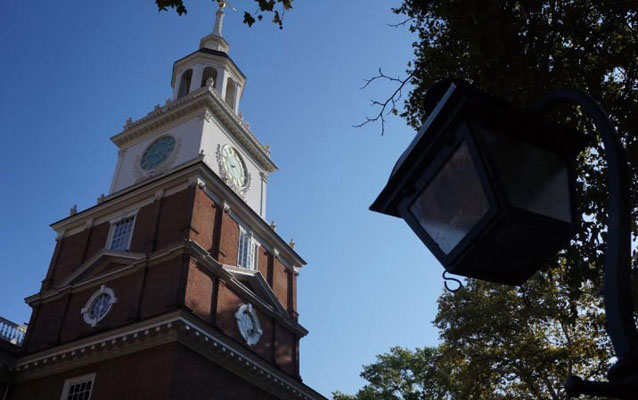Last updated: January 8, 2023
Place
Independence National Historical Park

NPS
Established in 1948, Independence National Historical Park covers more than 51 acres in downtown Philadelphia, Pennsylvania, and beyond. As an administrative unit of the National Park Service, Independence National Historic Park also manages and operates three other legislated national park units in and around the city of Philadelphia. The site includes Independence National Historical Park, Edgar Allan Poe National Historic Site, Gloria Dei Church National Historic Site, and Thaddeus Kosciusko National Memorial.
Established in 1948, Independence National Historical Park was created to protect the historic places associated with the birth of the American republic, standing as icons of freedom and democratic ideals for people around the world. The park spans more than 51 acres within the City of Philadelphia, preserving and interpreting a rich collection of the United States of America’s Colonial, Revolutionary, and Federal period heritage. The park’s designers were strongly influenced by the City Beautiful Movement as well as the trend toward colonial revival in design introduced at Williamsburg, Virginia. While the urban renewal movement in Philadelphia was underway, the National Park Service was working collaboratively with local preservationists and stakeholders in developing Independence National Historical Park. Pioneering historic structure restoration in the 1950s and 1960s, with architects, engineers, archeologists, curators, and historians working on Independence Hall as well as other park structures, landscapes, and collections, led to development of a modern methodology and rigorous standards for restoration and reconstruction that are still a model for the National Park Service and private sector professionals. Most of the park’s historic structures are located in the vicinity of the four landscaped blocks between Philadelphia’s Chestnut, Walnut, 2nd, and 6th Streets. Here, along these streets, amid these venerable houses and public buildings, colonists began their quest for freedom and independence. Here too, the United States of America was born and its ideals enacted in the Constitution.
The centerpiece of the park is Independence Hall, where the Declaration of Independence, the Articles of Confederation, and the United States Constitution were debated and adopted in the late 18th century. Independence Hall and nearby Congress Hall were the principal meetinghouses of the Second Continental Congress from 1775 to 1783 and the Constitutional Convention in the summer of 1787. In Independence Square, the Declaration of Independence was read publicly for the first time on July 8, 1776. The legacy of the nation’s founding documents—universal principles of freedom and democracy—has influenced lawmakers around the world and distinguished Independence Hall as a United Nations Educational, Scientific and Cultural Organization (UNESCO) World Heritage Site.
Across the street from Independence Square, the Liberty Bell, an iconic symbol of independence and an international symbol of freedom, is displayed in the Liberty Bell Center. Hung in the State House in 1753, it summoned the Pennsylvania Assembly to work. In the 1830s anti-slavery groups named it the Liberty Bell. The bell cracked sometime around 1846, but its message still rings out. Surrounding the Liberty Bell Center is the park’s Independence Mall, one of Philadelphia’s great outdoor public spaces, which runs between 5th and 6th Streets, from Chestnut Street to Race Street.
Independence National Historical Park is much more than Independence Hall and the Liberty Bell. The park preserves and interprets many of our country’s most important resources associated with the establishment of the government of the United States of America. Carpenters’ Hall is the site of the First Continental Congress held in September 1774. The Supreme Court of the United States first met at Philadelphia’s Old City Hall. The site of the President’s House, where George Washington and John Adams and their households lived and worked during their terms as the first and second presidents of the United States, prior to Adams’ move to the White House in 1800, is interpreted by the park, especially in the paradox of the Washingtons bringing their enslaved people to work and live there. Franklin Court preserves the site of Benjamin Franklin’s house and businesses, providing a window into the life and times of this founding father. Washington Square, one of William Penn’s five original squares, is home to the Tomb of the Unknown Soldier of the American Revolution.
The park also protects the First and Second Bank buildings of the United States; the Merchants Exchange Building; and the faithfully reconstructed social, cultural, and political center of Philadelphia during the park’s period of significance, the City Tavern. These are just a few of the many historic buildings and landscapes managed and protected by Independence National Historical Park.
With so many important places under its care, Independence National Historical Park works collaboratively with many partners and stakeholders in the stewardship of our national heritage. The park works closely with the city of Philadelphia and the state of Pennsylvania, and with the Independence Visitor Center Corporation jointly managing the Independence Visitor Center located on 6th and Market Streets. Some of the historic buildings in the park are still owned by private organizations such as the American Philosophical Society and the Carpenters’ Company of the City and County of Philadelphia, so the park must work closely with these groups on the protection and interpretation of these properties. The park is also involved with numerous houses of worship and congregations, whose churches and cemeteries are an integral part of the historic significance of the park. Congress created the National Constitution Center as a private nonprofit organization in the park, located in a federally owned building on the mall, to be a nonpartisan interpreter of the history of the Constitution and its current relevance. There are numerous civic organizations, nonprofit groups, corporations, and countless stakeholders locally, nationally, and internationally that the park engages with on a regular basis. The diverse interests and passion of the park’s many partners and stakeholders reflect the importance of buildings and resources protected by Independence National Historical Park.
